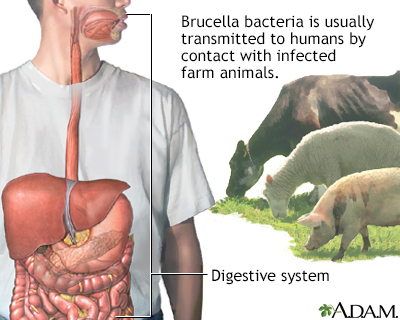Serology for brucellosis
Definition
Serology for brucellosis is a blood test to look for the presence of antibodies against brucella. These are the bacteria that cause the disease brucellosis.
Alternative Names
Brucella serology; Brucella antibody test or titer
How the Test is Performed
How to Prepare for the Test
There is no special preparation.
How the Test will Feel
When the needle is inserted to draw blood, some people feel moderate pain. Others feel only a prick or stinging. Afterward, there may be some throbbing or a slight bruise. This soon goes away.
Why the Test is Performed
Brucellosis is an infection that occurs from coming into contact with animals that carry brucella bacteria.
Your health care provider may order this test if you have signs or symptoms of brucellosis. People who often come in contact with animals or meat are most likely to get this disease. This includes:
- Slaughterhouse workers
- Farmers
- Veterinarians
Normal Results
A normal (negative) result usually means you have not come in contact with the bacteria that causes brucellosis. However, this test may not detect the disease at an early stage. Your provider may have you come back for another test in 10 days to 3 weeks.
Infection with other bacteria, such as Yersinia spp., Francisella spp., and Vibrio spp., and certain immunizations can cause false-positive results.
Normal value ranges may vary slightly among different laboratories. Some labs use different measurements or test different samples. Talk to your provider about the meaning of your specific test results.
What Abnormal Results Mean
An abnormal (positive) result usually means you have come in contact with the bacteria that causes brucellosis or a closely related bacteria.
However, this positive result does not mean that you have an active infection. Your provider will have you repeat the test after a few weeks to see if the test result increases. This increase is more likely to be a sign of a current infection.
Risks
There is little risk involved with having your blood taken. Veins and arteries vary in size from one person to another and from one side of the body to the other. Taking blood from some people may be more difficult than from others.
Other risks associated with having blood drawn are slight, but may include:
- Fainting or feeling lightheaded
- Multiple punctures to locate veins
- Hematoma (blood buildup under the skin)
- Excessive bleeding
- Infection (a slight risk any time the skin is broken)
Gallery



References
Gul HC, Erdem H. Brucellosis (Brucella species). In: Bennett JE, Dolin R, Blaser MJ, eds. Mandell, Douglas, and Bennett's Principles and Practice of Infectious Diseases. 9th ed. Philadelphia, PA: Elsevier; 2020:chap 226.
Wojewoda CM, Stempak LM. Medical bacteriology. In: McPherson RA, Pincus MR, eds. Henry's Clinical Diagnosis and Management by Laboratory Methods. 24th ed. Philadelphia, PA: Elsevier; 2022:chap 57.